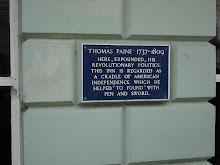
Oh dear - nostalgia again. And possibly the most boring photograph ever taken.
This illuminated AA sign in Tetbury brought back all sorts of memories. Once a common site outside hotels all over the country these shining beacons seemed to promise a cosy and comfortable welcome within. Not sure if that was always true, but to a kid in the back of the family Vanguard looking out on rain streaked streets they delivered a strange feeling of comfort and familiarity signalling endorsement by that august body The AA; after all, weren't they the trusted friends of the motorist? (help always at hand from a friendly patrolman on his motorbike and sidecar in his leather gaiters and sturdy gauntlets) - not to my dad they weren't, he thought that anyone posessing a car should also be privy to the sort of mechanical know-how which could effect a roadside repair should a breakdown occur. Of course he forgot that not everyone was a skilled mechanic nor did they have the inclination to be one. Perfectly relishing the prospect of a disconnected propshaft or some such calamity he would fling open the boot of whatever old banger was our current family transport, throw on an ancient oil-stained macintosh and lay down in the road to scrabble under the car. It mattered not where the trouble lay, it always seemed to involve lying down in the road first - the underpinnings of motor cars were always the root, it appeared, of all maladies.
Other members of our family were less inclined to plunge around in the darkness when disaster struck. My mother's sister was a confirmed motorist and staunch AA member- her yellow 'Members Handbook' arrived promptly every year and I found it absolutely fascinating, listing, in the sort of detail in which trainspotters delight, garages, the type of cars they specialised in, petrol they sold and of course the hotels where it was suitable for members to stay. Maps too, distances to and from major towns and all the minutae deemed to be vital information for fifties motorists. She proudly carried an early brass version of the AA badge which had belonged to her father on the radiator grill of whatever was her current car. Oh yes, she was the living embodiment of what the AA liked to think it stood for - representing the middle class motorist of the Wolseley, Riley, Humber kind - motoring for the masses brought an influx of Ford, Austin and Morris drivers too, let alone the occasional (heaven forbid) Bond three wheeler owner too. Mind you, the AA was always rather eclipsed in class terms by the RAC - they couldn't fail to be, what with the word 'Royal' in the title and a very swanky club in London. It was rare for us kids to spot an RAC roadside 'Box', with the 'AA's' being far more common. For those who don't remember, both the AA and RAC had what were in essence private telephone boxes dotted about all over the country - no mobile phones remember - and every member was given a yale key which opened them in order to summon help from a patrolman. Of course each patrolman had his own patch and took great pride in maintaining the appearance of his call box. Some even planted flowers and erected miniature white painted picket fences around them. One such was always a marker for us returning home from a day at Walton-on-the-Naze, we passed it at Takely, close to where Stansted Airport now sprawls into the countryside, and the patrolman, looking very military in said jodhpurs, gaiters, cap and gauntlets would not have been out of place on the parade ground at Sandhurst. Passing him, it was a matter of fifteen minutes before we reached home, but not until the illuminated AA sign for The Foxley Hotel hove into view. All 'Jacobethan' flummery and strictly saloon bar only, this is where the aforementioned aunt and her 'boyfriend' used to stay for an illicit night or two on the pretext of visiting us. I'm sure the AA never had this sort of risqué behaviour in mind when making their recommendations - or did they? Our passed-on copies of previous AA guides had strategic hotel entries discreetly marked in pencil, mainly around the Thames Valley and Surrey area. What fun! You knew the day would be taking a turn for the better when you saw the welcoming yellow lantern.























